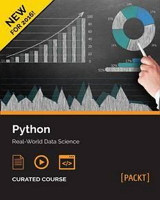
Python: Real-World Data Science
- Length: 1255 pages
- Edition: 1
- Language: English
- Publisher: Packt Publishing
- Publication Date: 2016-01-06
- ISBN-10: 1786465167
- ISBN-13: 9781786465160
Unleash the power of Python and its robust data science capabilities About This Book * Unleash the power of Python 3 objects * Learn to use powerful Python libraries for effective data processing and analysis * Harness the power of Python to analyze data and create insightful predictive models * Unlock deeper insights into machine learning with this vital guide to cutting-edge predictive analytics Who This Book Is For Entry-level analysts who want to enter in the data science world will find this course very useful to get themselves acquainted with Python’s data science capabilities for doing real-world data analysis. What You Will Learn * Install and setup Python * Implement objects in Python by creating classes and defining methods * Get acquainted with NumPy to use it with arrays and array-oriented computing in data analysis * Create effective visualizations for presenting your data using Matplotlib * Process and analyze data using the time series capabilities of pandas * Interact with different kind of database systems, such as file, disk format, Mongo, and Redis * Apply data mining concepts to real-world problems * Compute on big data, including real-time data from the Internet * Explore how to use different machine learning models to ask different questions of your data In Detail The Python: Real-World Data Science course will take you on a journey to become an efficient data science practitioner by thoroughly understanding the key concepts of Python. This learning path is divided into four modules and each module are a mini course in their own right, and as you complete each one, you’ll have gained key skills and be ready for the material in the next module. The course begins with getting your Python fundamentals nailed down. After getting familiar with Python core concepts, it’s time that you dive into the field of data science. In the second module, you’ll learn how to perform data analysis using Python in a practical and example-driven way. The third module will teach you how to design and develop data mining applications using a variety of datasets, starting with basic classification and affinity analysis to more complex data types including text, images, and graphs. Machine learning and predictive analytics have become the most important approaches to uncover data gold mines. In the final module, we’ll discuss the necessary details regarding machine learning concepts, offering intuitive yet informative explanations on how machine learning algorithms work, how to use them, and most importantly, how to avoid the common pitfalls. Style and approach This course includes all the resources that will help you jump into the data science field with Python and learn how to make sense of data. The aim is to create a smooth learning path that will teach you how to get started with powerful Python libraries and perform various data science techniques in depth.
Table of Contents
1. Course Module 1: Python Fundamentals
1. Introduction and First Steps – Take a Deep Breath
2. Object-oriented Design
3. Objects in Python
4. When Objects Are Alike
5. Expecting the Unexpected
6. When to Use Object-oriented Programming
7. Python Data Structures
8. Python Object-oriented Shortcuts
9. Strings and Serialization
10. The Iterator Pattern
11. Python Design Patterns I
12. Python Design Patterns II
13. Testing Object-oriented Programs
14. Concurrency
2. Course Module 2: Data Analysis
1. Introducing Data Analysis and Libraries
2. NumPy Arrays and Vectorized Computation
3. Data Analysis with pandas
4. Data Visualization
5. Time Series
6. Interacting with Databases
7. Data Analysis Application Examples
3. Course Module 3: Data Mining
1. Getting Started with Data Mining
2. Classifying with scikit-learn Estimators
3. Predicting Sports Winners with Decision Trees
4. Recommending Movies Using Affinity Analysis
5. Extracting Features with Transformers
6. Social Media Insight Using Naive Bayes
7. Discovering Accounts to Follow Using Graph Mining
8. Beating CAPTCHAs with Neural Networks
9. Authorship Attribution
10. Clustering News Articles
11. Classifying Objects in Images Using Deep Learning
12. Working with Big Data
13. Next Steps…
4. Course Module 4: Machine Learning
1. Giving Computers the Ability to Learn from Data
2. Training Machine Learning Algorithms for Classification
3. A Tour of Machine Learning Classifiers Using scikit-learn
4. Building Good Training Sets – Data Preprocessing
5. Compressing Data via Dimensionality Reduction
6. Learning Best Practices for Model Evaluation and Hyperparameter Tuning
7. Combining Different Models for Ensemble Learning
8. Predicting Continuous Target Variables with Regression Analysis
A. Reflect and Test Yourself! Answers
B. Bibliography







